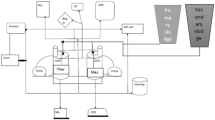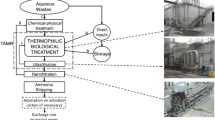Abstract
Foam formation in the excess sludge treatment facilities of biological wastewater treatment plants (WWTPs) may represent a critical issue as it could lead to several operative problems and reduce the overall plant performance. This trouble also affects a novel technology recently proposed for sludge minimization, the thermophilic membrane reactor (TMR), operating with alternate aeration/non-aeration cycles. This technology, which has proven to be extremely resilient and suitable for treating industrial wastewater of different nature, demonstrated a high potential also as a solution for integrating existing WWTPs, aiming at the “zero sludge production.” In this work, an experimental study was conducted with a TMR pilot plant (fed daily with thickened sewage sludge) by adjusting the duration of aeration/non-aeration alternate cycles. Extracellular polymeric substance (EPS) concentration (and its soluble and bound fractions) has been monitored along with foaming power indices. The results highlight that foaming can be correlated to the presence of soluble protein fraction of EPS. Moreover, EPS production seems to be reduced by increasing the duration of the non-aeration cycles: optimal operating conditions resulted 2 h of aeration followed by 6 h of non-aeration. These conditions allow to obtain an EPS concentration of 500 mg L−1 with respect to 2300 mg L−1 measured at the beginning of experimental work.






Similar content being viewed by others
Abbreviations
- ATAD:
-
Autothermal thermophilic aerobic digestion
- COD:
-
Chemical oxygen demand
- CV:
-
Coefficient of variation
- EPS:
-
Extracellular polymeric substance
- EPSb :
-
Bound extracellular polymeric substance
- EPSb,c :
-
Carbohydrate fraction of bound extracellular polymeric substance
- EPSb,p :
-
Protein fraction of bound extracellular polymeric substance
- FP:
-
Foaming power index calculated as consumed sample per liter of supplied air
- FP2:
-
Foaming power index calculated as foam volume produced per liter of supplied air
- MBR:
-
Membrane bioreactor
- R 2 :
-
Coefficient of determination
- SMP:
-
Soluble microbial products
- SMPc :
-
Carbohydrate fraction of soluble microbial products
- SMPp :
-
Protein fraction of soluble microbial products
- TMR:
-
Thermophilic membrane reactor
- TN:
-
Total nitrogen
- TP:
-
Total phosphorus
- TS:
-
Total solids
- UF:
-
Ultrafiltration
- UM:
-
Unit of measurement
- VS:
-
Volatile solids
- WWTP:
-
Wastewater treatment plant
References
Baudez J-C, Gupta RK, Eshtiaghi N, Slatter P (2013) The viscoelastic behaviour of raw and anaerobic digested sludge: strong similarities with soft-glassy materials. Water Res 47(1):173–180. doi:10.1016/j.watres.2012.09.048
Bertanza G, Collivignarelli MC, Crotti BM, Pedrazzani R (2010) Integration between chemical oxidation and membrane thermophilic biological process. Water Sci Technol 61(1):227–234. doi:10.2166/wst.2010.793
Capodici M, Di Bella G, Nicosia S, Torregrossa M (2015) Effect of chemical and biological surfactants on activated sludge of MBR system: microscopic analysis and foam test. Bioresource Technol 177:80–86. doi:10.1016/j.biortech.2014.11.064
Collivignarelli MC, Abbà A, Bertanza G (2014) Treatment of high strength pharmaceutical wastewaters in a thermophilic aerobic membrane reactor (TAMR). Water Res 63:190–198. doi:10.1016/j.watres.2014.06.018
Collivignarelli MC, Castagnola F, Sordi M, Bertanza G (2015a) Treatment of sewage sludge in a thermophilic membrane reactor (TMR) with alternate aeration cycles. J Environ Manag 162:132–138. doi:10.1016/j.jenvman.2015.07.031
Collivignarelli MC, Bertanza G, Sordi M, Pedrazzani R (2015b) High-strength wastewater treatment in a pure oxygen thermophilic process: 11-year operation and monitoring of different plant configurations. Water Sci Technol 71(4):588–596. doi:10.2166/wst.2015.008
Collivignarelli MC, Abbà A, Bertanza G (2015c) Why use a thermophilic aerobic membrane reactor for the treatment of industrial wastewater/liquid waste? Environ Technol 36:2115–2124. doi:10.1080/09593330.2015.1021860
Dai X, Luo F, Dai L, Dong B (2013) Degradation of extracellular polymeric substances (EPS) in anaerobic digestion of dewatered sludge. Procedia Environmental Sciences 18:515–521. doi:10.1016/j.proenv.2013.04.069
Davenport RJ, Pickering RL, Goodhead AK, Curtis TP (2008) A universal threshold concept for hydrophobic mycolata in activated sludge foaming. Water Res 42(13):3446–3454. doi:10.1016/j.watres.2008.02.033
de los Reyes FL III, Raskin L (2002) Role of filamentous microorganisms in activated sludge foaming: relationship of mycolata levels to foaming initiation and stability. Water Res 36(2):445–459. doi:10.1016/S0043-1354(01)00227-5
Di Bella G, Torregrossa M (2013) Foaming in membrane bioreactors: identification of the causes. J Environ Manag 128:453–461. doi:10.1016/j.jenvman.2013.05.036
Di Bella G, Torregrossa M, Viviani G (2011) The role of EPS concentration in MBR foaming: analysis of a submerged pilot plant. Bioresource Technol 102(2):1628–1635. doi:10.1016/j.biortech.2010.09.028
Dubois M, Gilles KA, Hamilton JK, Rebers PA, Smith F (1956) Colorimetric method for determination for sugars and related substances. Anal Chem 28(3):350–356. doi:10.1021/ac60111a017
Frigon D, Guthrie RM, Bachman GT, Royer J, Bailey B, Raskin L (2006) Long-term analysis of a full-scale activated sludge wastewater treatment system exhibiting seasonal biological foaming. Water Res 40(5):990–1008. doi:10.1016/j.watres.2005.12.015
Ganidi N, Tyrrel S, Cartmell E (2009) Anaerobic digestion foaming causes—a review. Bioresource Technol 100(23):5546–5554. doi:10.1016/j.biortech.2009.06.024
Gao WJ, Qu X, Leung KT, Liao BQ (2012) Influence of temperature and temperature shock on sludge properties, cake layer structure, and membrane fouling in a submerged anaerobic membrane bioreactor. J Membr Sci 421–422:131–144. doi: 10.1016/j.memsci.2012.07.003
Guo F, Wang Z-P, Yu K, Zang T (2015) Detailed investigation of the microbial community in foaming activated sludge reveals novel foam formers. Scientific Reports 5:7637. doi:10.1038/srep07637
Guo W-Q, Yang S-S, Xiang W-S, Wang X-J, Ren N-Q (2013) Minimization of excess sludge production by in-situ activated sludge treatment processes—a comprehensive review. Biotechnol Adv 31(8):1386–1396. doi:10.1016/j.biotechadv.2013.06.003
Laspidou CS, Rittmann BE (2002) A unified theory for extracellular polymeric substances, soluble microbial products, and active and inert biomass. Water Res 36(11):2711–2720. doi:10.1016/S0043-1354(01)00413-4
Layden MN, Mavinic DC, Kelly HG, Moles R (2007) Autothermal thermophilic aerobic digestion (ATAD)—part I: review of origins, design, and process operation. J Environ Eng Sci 6(6):665–678. doi:10.1139/S07-015
Le-Clech P, Chen V, Fane TAG (2006) Fouling in membrane bioreactors used in wastewater treatment. J Membrane Sci 284(1–2):17–53. doi:10.1016/j.memsci.2006.08.019
Lim BS, Choi BC, Yu SW, Lee CG (2007) Effects of operational parameters on aeration on/off time in an intermittent aeration membrane bioreactor. Desalination 202:77–82. doi:10.1016/j.desal.2005.12.041
Liu Y, Tay J-H (2001) Strategy for minimization of excess sludge production from the activated sludge process. Biotechnol Adv 19(2):97–107. doi:10.1016/S0734-9750(00)00066-5
Lowry OH, Rosenbrough NJ, Farr AI, Randall RJ (1951) Protein measurement with Folin phenol reagent. J Biol Chem 193:265–275
Morgan JW, Forster CF, Evison L (1990) A comparative study of the nature of biopolymers extracted from anaerobic and activated sludges. Water Res 24(6):743–750. doi:10.1016/0043-1354(90)90030-A
Nakajima J, Mishima I (2005) Measurement of foam quality of activated sludge in MBR. Acta Hydrochim Hydrobiol 33(3):232–239. doi:10.1002/aheh.200400575
Neyens E, Baeyens J, Dewil R, De heyder B (2004) Advanced sludge treatment affects extracellular polymeric substances to improve activated sludge dewatering. J Hazard Mater 106(2–3):83–92. doi:10.1016/j.jhazmat.2003.11.014
Oerther DB, de los Reyes FL III, de los Reyes MF, Raskin L (2001) Quantifying filamentous microorganisms in activated sludge before, during, and after an incident of foaming by oligonucleotide probe hybridizations and antibody staining. Water Res 35(14):3325–3336. doi:10.1016/S0043-1354(01)00057-4
Pérez-Elvira SI, Nieto Diez P, Fdz-Polanco F (2006) Sludge minimisation technologies. Rev Environ Sci Biotechnol 5(4):375–398. doi:10.1007/s11157-005-5728-9
Pitt P, Jenkins D (1990) Causes and control of Nocardia in activated sludge. Res J Water Pollut C 62(2):143–150
Rosenberger S, Kraume M (2003) Filterability of activated sludge in membrane bioreactors. Desalination 151(2):195–200. doi:10.1016/S0011-9164(02)00998-0
Sheng G-P, Yu H-Q, Li X-Y (2010) Extracellular polymeric substances (EPS) of microbial aggregates in biological wastewater treatment systems: a review. Biotechnol Adv 28(6):882–894. doi:10.1016/j.biotechadv.2010.08.001
Subramanian B, Pagilla KR (2015) Mechanisms of foam formation in anaerobic digesters. Colloid Surface B 126:621–630. doi:10.1016/j.colsurfb.2014.11.032
Xie B, Dai X-C, Xu Y-T (2007) Cause and pre-alarm control of bulking and foaming by Microthrix parvicella—a case study in triple oxidation ditch at a wastewater treatment plant. J Hazard Mater 143(1–2):184–191. doi:10.1016/j.jhazmat.2006.09.006
Zhang X, Bishop PL, Kinkle BK (1999) Comparison of extraction methods for quantifying extracellular polymers in biofilms. Water Sci Technol 39(7):211–218. doi:10.1016/S0273-1223(99)00170-5
Zohu Z, Meng F, Lu H, Jia X (2013) Denitrification-caused suppression of soluble microbial products (SMP) in MBRs used for biological nitrogen removal. AICHE J 59(10):3569–3573. doi:10.1002/aic.14189
Acknowledgments
The authors wish to thank Idroclean Spa (Casirate d’Adda, BG, Italy) for technical and financial support to the research.
Author information
Authors and Affiliations
Corresponding author
Ethics declarations
Conflict of interest
The authors declare that they have no conflict of interest.
Human and animal rights and informed consent
This article does not contain any studies with human participants or animals performed by any of the authors.
Informed consent
Informed consent was obtained from all individual participants included in the study.
Additional information
Responsible editor: Angeles Blanco
Rights and permissions
About this article
Cite this article
Collivignarelli, M.C., Castagnola, F., Sordi, M. et al. Sewage sludge treatment in a thermophilic membrane reactor (TMR): factors affecting foam formation. Environ Sci Pollut Res 24, 2316–2325 (2017). https://doi.org/10.1007/s11356-016-7983-4
Received:
Accepted:
Published:
Issue Date:
DOI: https://doi.org/10.1007/s11356-016-7983-4




